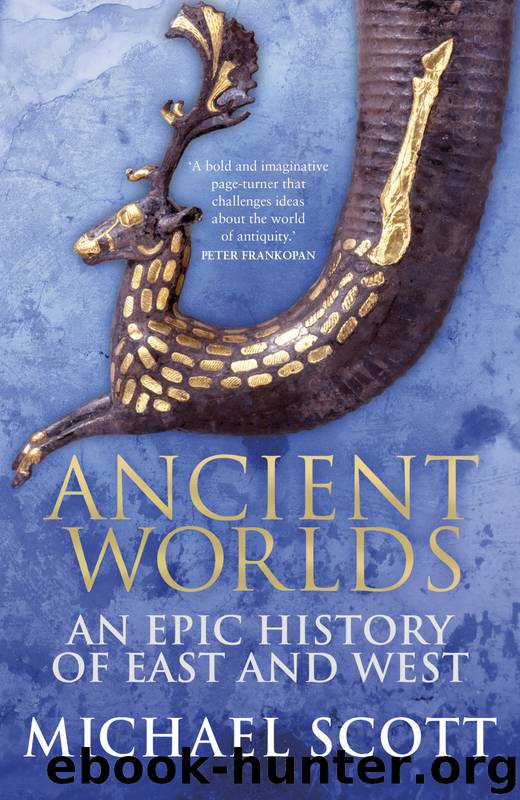Ancient Worlds by Michael Scott

Author:Michael Scott
Language: eng
Format: epub
Publisher: Random House
Published: 2016-06-29T16:00:00+00:00
PART III
RELIGIOUS CHANGE IN A CONNECTED WORLD
TIMELINE
c. 563 BCE (or 480 BCE): Birth of the Buddha in India
150 BCE: King Menander (Milinda) converted to Buddhism by monk Nagasena
25 CE: Beginning of Eastern Han Dynasty
66 CE: Tiridates I of Armenia travels to Rome to be crowned by Roman Emperor Nero
68–75 CE: First Buddhist monastery (‘White Horse Monastery’) built at Luoyang
148 CE: Arrival of An Shigao in China as Buddhist monk and translator
220 CE: End of Eastern Han Dynasty and beginning of Three Kingdom Period in China
257 CE: Father of future Tiridates the Great murdered; Tiridates sent to Rome (and Gregory to Caesarea)
265 CE: Beginning of Western Jin Dynasty in China
284 CE: Beginning of reign of Roman Emperor Diocletian.
286 CE: First simultaneous translation of Buddhist text into Chinese completed by Dharmaraksa
300 CE: Ghatotkacha Gupta rules in India
303 CE: Diocletian initiates persecution of Christians in Roman Empire
303/314 CE: Conversion of Tiridates the Great to Christianity
304 CE: The Xiongnu break through into Northern China – beginning of Sixteen Kingdoms Period
306 CE: Constantine I declared Augustus by his troops.
310–11 CE: Chang’an and Luoyang destroyed
312 CE: Constantine defeats Maxentius at Milvian Bridge
313 CE: The Edict of Milan, enacted by Constantine and Licinus, decrees religious tolerance
314 CE: Constantine convenes Council of Arles
316 CE: Beginning of Eastern Jin dynasty in China based around capital at Nanjing
320 CE: Chandragupta I begins rule in northern India
324 CE: Constantine I defeats Licinius at Chrysopolis
324 CE: Meeting of Constantine, Tiridates, Gregory, and Pope Silvester
325 CE: Constantine I calls the Council of Nicaea; Gregory ‘the Illuminator’ dies
327 CE: Second Council of Nicaea
330 CE: Constantinople is founded on the site of old Byzantium as ‘the new Rome;’ Tiridates the Great dies
335 CE: Samudragupta becomes ruler of the Gupta Empire; Council of Tyre in Roman Empire
337 CE: Death of Constantine
350 CE: Huns begin to invade the Sassanid Empire
353 CE: First Armenian Council conducted by Catholicos Nerses
360 CE: Julian the Apostate is proclaimed emperor and attempts to revive paganism.
375 CE: Chandragupta II becomes ruler of the Gupta Empire.
376 CE: The Visigoths flee the Huns, entering the Eastern Roman Empire
380 CE: Edict issued by Emperor Theodosius on correct form of Christian belief and worship
381 CE: Emperor Xiaowu formally accepts and establishes Buddhism at his court in China
386 CE: Start of Northern Dynasty Period in China
387 CE: Partition of Armenia between the Roman and Sassanian Empires
391 CE: Christianity becomes official religion of Roman Empire and paganism is actively suppressed
394 CE: Battle of River Frigidus between the army of Theodosius I and the army of pagan-sympathising Western Roman ruler Eugenius.
395 CE: Buddhist King of Sri Lanka despatches gift to Emperor Xiaowu in China (which arrives 405 CE)
395–398 CE: Huns invade Roman territories.
395 CE: Theodosius I dies, causing the Roman Empire to split permanently.
399 CE: Chinese Buddhist monk Faxian travels on foot to India to acquire Buddhist texts.
401 CE: Chinese Buddhist monk Kumarajiva enters court in Chang'an and begins translations of Buddhist texts.
410 CE: The Sack of Rome by Visigoths led by King Alaric.
415 CE: Founding of Nalanda University in
Download
This site does not store any files on its server. We only index and link to content provided by other sites. Please contact the content providers to delete copyright contents if any and email us, we'll remove relevant links or contents immediately.
The Daily Stoic by Holiday Ryan & Hanselman Stephen(2731)
The Fate of Rome: Climate, Disease, and the End of an Empire (The Princeton History of the Ancient World) by Kyle Harper(2463)
People of the Earth: An Introduction to World Prehistory by Dr. Brian Fagan & Nadia Durrani(2366)
Ancient Worlds by Michael Scott(2137)
Babylon's Ark by Lawrence Anthony(2092)
Foreign Devils on the Silk Road: The Search for the Lost Treasures of Central Asia by Peter Hopkirk(2076)
India's Ancient Past by R.S. Sharma(2005)
MOSES THE EGYPTIAN by Jan Assmann(1994)
The Complete Dead Sea Scrolls in English (7th Edition) (Penguin Classics) by Geza Vermes(1867)
Lost Technologies of Ancient Egypt by Christopher Dunn(1818)
The Daily Stoic by Ryan Holiday & Stephen Hanselman(1817)
The Earth Chronicles Handbook by Zecharia Sitchin(1772)
24 Hours in Ancient Rome by Philip Matyszak(1706)
Alexander the Great by Philip Freeman(1680)
Aztec by Gary Jennings(1572)
The Nine Waves of Creation by Carl Johan Calleman(1536)
Curse Tablets and Binding Spells from the Ancient World by Gager John G.;(1530)
Before Atlantis by Frank Joseph(1502)
Earthmare: The Lost Book of Wars by Cergat(1485)
